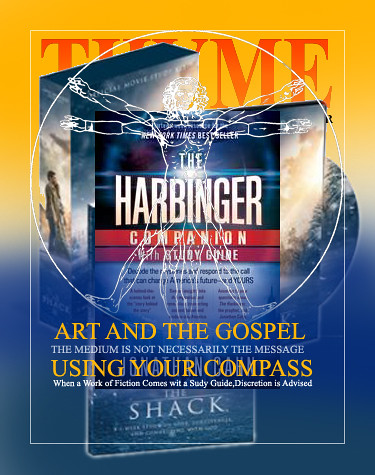
Art is an important medium for presenting truth, discernment is advised.
To the real Christian, the Gospel’s unique truths are the center to which she gravitates – the very sun of her solar system, the soul of the world. They are the origin of all that is excellent and lovely, the source of light and life, motion and warmth. From them comes all creative energy. Our intellects would be cold and comfortless without their light and guidance.” – William Wilberforce
Not long ago The DaVinci Code came upon the literary scene and this work of fiction, based on Gnostic writings, became the center of much discussion about Faith in our day. One of the elders of our church conducted a very thorough study in which he pointed out what was based on Holy Writ, and what was based on these non-canonical sources. It was a very profitable investigation into what we believe and why. Naturally there are those who are unfamiliar with the Gospel who will read such a work at face value, not digging deeper to find that it has been sourced from works that are of varied integrity. Yes, this is dangerous, but perhaps there is also a benefit to be had by opening a discussion.
As our church excitedly prepared to enter into ministry to our surrounding neighborhoods, the Harbinger phenomenon exploded. Here was a novel that drew from Old Testament Prophecy and Kaballa (a form of Jewish Mysticism) to create a story about a modern day 'unfolding' of prophecy. I read the book and found it interesting, but never thought of it as more than a work of fiction. Turns out the author of this work was regularly appearing on Jim Bakker's show (I did not know he was still around). He was joined by a guy hawking 'survival food' packages. Yes, this was now being presented as something more than a novel.
What was troubling was that our little men's Bible study became sidetracked as a person of strong personality took charge and used it as a forum for promoting this line of thinking. Soon there was no Bible study at all, only a discussion of Prepping! Now I am one who believes in having an adequate pantry and a reserve of firewood. I could not, however, see the urgency my friend did He wanted the church to go all out warning people about the coming 'Great Shaking.' Unfortunately "Go and make disciples" was just not all that important anymore. I was sitting in a coffee house in Crozet, having just met a client, when I had a fairly honest conversation with a wise Pastor who I knew who just happened to be there using the WIFI as he counseled people around the globe.
He told me that the same thing had happened in his church. He had had to come down pretty strongly to put a lid on it. It was not advancing the Gospel. It was obfuscating it. The publisher of this work had put out a companion "Study Guide" and DVDs. Though never denying that this was a work of fiction, the publisher was complicit in allowing it to exist as something more. Seeing people running around so swayed by a work of fiction prompted me to investigate deeper. I had written PONTIFUS, my own Futurist fictional novel, and I pitched it to a Christian publishing house. For an investment of the down payment of my house, I could score a box of books to sit in my garage until my friends all bought a copy or the world ended.
Seriously, I learned that publishing, Sacred or secular, has a strong push to make money. That is not necessarily bad, but I do feel it provides some temptation of the wrong kind. If an author sells a lot of books, it is automatically assumed that he or she will produce more. DVDs and 'study guides' add to the potential profit margin. A popular author of parenting material once confessed to Bible teacher David Jeremiah that he was driven by the demands of a column he wrote to provide new material. One day he said to himself: "My Lord!, I am making this all way more complicated than it actually has to be." You see, he had to continually come up with problems to be solved... in his column.
Using Your Compass
I had the privilege of speaking to some very bright young people recently, and I recounted to them this story:
In the movie: “The Longest Day,” which tells the story of Operation Overlord, the D-Day invasion of Normandy, John Wayne plays Lt. Col. Benjamin Vandervoort, commander of the 89th Division. There is a moment when he comes upon a road sign pointing out the direction to St. Mere Eglise, their objective. His men have already dutifully began to march in that direction.
Suddenly the Colonel calls out: “Am I the only one in this unit that uses a compass?”
It turns out that the enemy has turned the sign around to lead them the wrong way! Vandervoort orders his men to turn around. He glances toward the sign: “Knock it Down!” he orders. And so we consider the voices that speak to us… offering to direct us, in our own day and time. How do we know which signs are right? What ‘compass’ is there to guide us? Are there signs around us that we should knock down?”
The moral of the story is clear. Be it True North or G-d-Breathed Scripture, there is always the need to go to a dependable primary source when we need to establish direction. That is the danger of 'companion' study guides. If they do not weed out secondary sources from Holy Writ, they present the potential to be as misleading as the sign to St. Mere Eglise!
That does not mean that it is wrong to creatively present the Gospel in fiction. Most of us love the Chronicles of Narnia by C. S. Lewis. Rowan Williams writes in his book The Lion's World, A Journey Into the Heart of Narnia [1.] that even this great presentation of the Gospel in story presents some problems that need further study if one is to resolve them. Ultimately though: “Lewis believed he had a responsibility to spread the Gospel through his writing. But he also felt strongly that Christianity's core beliefs were the most important, and that he shouldn't get involved in anything not central to them.” – Jonathan Luxmoore [2.]
Sadly, modern writing sometimes seems more concerned with presenting 'a new thing' than a faithful rendering of the Gospel. Dr. Gary Gilley [3.] writes: “The Harbinger is one of the hottest selling books today. It is a quasi-fictional story reminiscent of novels such as The Da Vinci Code or The Shack. Each of these books involves mystery and intrigue, and has a serious message that the authors want to convey. Dan Brown, in The Da Vinci Code, wanted to cast doubt on the Christian message and interject the teaching of ancient Gnosticism. The Shack portrays a new-age, unconditionally accepting view of God which promotes universalism. The Harbinger is warning America that God’s judgment is imminent unless the country repents and turns to the Lord and that very soon.”
Repentance would indeed be a worthy goal, but a friend pointed out that perhaps the undesirable consequence of the judgement message coupled with survival food advertisements is more of a message that you can "hide" from accountability by "bugging out." Those outside the fold and young Millenials are not likely to come weeping to the altar because of clever stories of sycamores and fir trees. Though the strong emotional appeal of The Shack is likely to spark some spiritual discussion, it in itself does little to lead a person to true Faith. I do not know how the accompanying 'study guide' bridges the gap between fanciful artistic license and hard discussion of Spiritual Reality. Perhaps it would be well to study instead how God is depicted in Inspired Texts. If art leads us to pursue Truth, it has served the work!
But I would be remiss if I were to leave at simply criticizing certain works of art for their ability to mislead; though indeed it is my hope that more partakers of the arts exercise appropriate discernment. The artist’s freedom to offer unique visions is not necessarily a bad thing. In fact, it is much needed. One example might be the portrayal of the Divine by Morgan Freeman in the Bruce Almighty and Evan Almighty movies. Freeman actually does a masterful job of portraying a Divine interacting with humanity. There are some moments in these films that are genuinely thought provoking. In fact, we may enjoy a wide sampling of creative work and find inspiration even in the most unlikely of places. Like C. S. Lewis, however, we ourselves must not be diverted from the guidance of essential truth. Indeed our knowledge of Divine truth will illuminate the truth to be gleaned from many a good story, whoever the writer.
Lewis was ultimately drawn to the Gospel because his fellow Inklings were able to show him that the great truth of God was indeed seen in the noble aspirations to be found in myth. His Faith had indeed been dulled by his teachers’ rather arbitrary statement that “all the myths are false,” and only the Gospel is true. When Lewis was able to see that men and women of all stripes wrote works that aspired to great truth, he found that they led him to Faith. That should be the goal of our pursuit of art and our examination of it.

Bradford pear blossoms in snow. Photo by Bob Kirchman.
